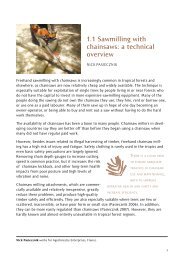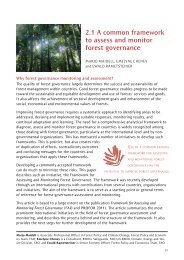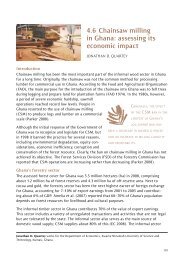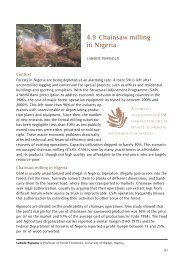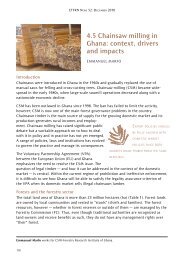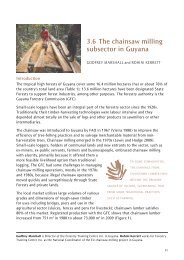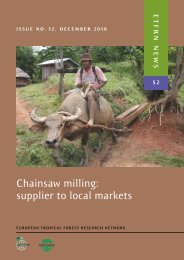Chainsaw milling: supplier to local markets - European Tropical ...
Chainsaw milling: supplier to local markets - European Tropical ...
Chainsaw milling: supplier to local markets - European Tropical ...
Create successful ePaper yourself
Turn your PDF publications into a flip-book with our unique Google optimized e-Paper software.
3.8 The impact of REDD+<br />
projects on chainsaw<br />
<strong>milling</strong> in peru<br />
LUCIO BROTTO<br />
introduction<br />
most forest degradation and deforestation occurs in the tropics; they account for at<br />
least 15% of the global anthropogenic emissions of greenhouse gases (van der werf et al.<br />
2009). Timber harvesting, either small scale or industrial, is one of the major direct causes<br />
of tropical forest degradation and deforestation (Geist and lambin 2001). with the first<br />
reducing Emissions from Deforestation and Forest Degradation (rEDD+) 1 projects<br />
under development in the voluntary carbon market, it is possible <strong>to</strong> better understand<br />
their impacts on timber harvesting, particularly on chainsaw <strong>milling</strong> (Csm).<br />
Forest products market and legislation in peru<br />
with 67.9 million hectares (ha), peru has the ninth largest forest area in the world and the<br />
second largest in latin america after brazil. his<strong>to</strong>rically, the deforestation rate has been<br />
low: –0.1% between 1990 and 2005 (Fao 2009 and 2010). Despite these forest resources,<br />
the forest sec<strong>to</strong>r accounts for only 1.1% of the<br />
national Gross Domestic product (lebedys 2008).<br />
selecTing appropriaTe<br />
most peruvian forests (about 66 million ha) are<br />
projecT acTiviTies and<br />
located in the tropical amazon known as selva and<br />
are relatively inaccessible. The andes mountains<br />
separate the selva from the pacific coast, where<br />
most economic and commercial activities take redd+ projecT developers address<br />
place. peru tends <strong>to</strong> import high-value products csm in a meaningful way.<br />
(e.g., finished high-quality paper) and export<br />
secondary processed wood products (e.g., sawnwood). as a result, import values are higher<br />
than export values, with a difference of us$288 million in 2007 (inEi 2008).<br />
carefully undersTanding<br />
<strong>local</strong> realiTies will help<br />
in the last ten years, the peruvian government has favored the international timber<br />
market through reforms in the forestry sec<strong>to</strong>r, trading and infrastructure. with the Forest<br />
and Wildlife Law 3 and the 2002 logging title reform, roughly one sixth of the forest area<br />
(10.4 million ha) became permanent commercial timber concessions (oliveira et al. 2007)<br />
with a minimum title duration of 40 years. The 2009 free trade agreement with the united<br />
Lucio brot<strong>to</strong> is with the Department of land, agriculture and Forestry systems, Faculty of agriculture,<br />
university of padua, italy. 2<br />
105



